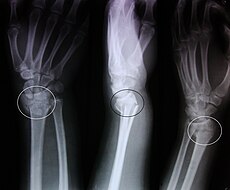Colles' fracture
A Colles' fracture, also Colles fracture, is a fracture of the distal radius in the forearm with dorsal (posterior) displacement of the wrist and hand. The fracture is sometimes referred to as a "dinner fork" or "bayonet" deformity due to the shape of the resultant forearm. For a more detailed discussion see distal radius fracture.
Terminology
The term Colles fracture is classically used to describe a fracture at the distal end of the radius, at its cortico-cancellous junction. However, now the term tends to be used loosely to describe any fracture of the distal radius, with or without involvement of the ulna, that has dorsal displacement of the fracture fragments. Colles himself described it as a fracture that “takes place at about an inch and a half (38mm) above the carpal extremity of the radius” and “the carpus and the base of metacarpus appears to be thrown backward”.[2]
The classic Colles fracture has the following characteristics:[3]
- Transverse fracture of the radius
- 1 inch (2.54 cm) proximal to the radio-carpal joint
- dorsal displacement and angulation
Causes
The fracture is most commonly caused by people falling onto a hard surface and breaking their fall with outstretched arms - falling with wrists flexed would lead to a Smith's fracture. It can also be caused by overuse. Orignally it was described in elderly people, post-menopausal women. It usually occurs about an inch or two proximal to the radio-carpal joint with posterior and lateral displacement of the distal fragment resulting in the characteristic "dinner fork" or "bayonet" like deformity.Colles' fracture is a common fracture in people with osteoporosis, second only to vertebral fractures.
Diagnosis
- Dorsal tilt
- Radial shortening
- Loss of ulnar inclination
- Radial angulation of the wrist
- Dorsal displacement of the distal fragment
- Comminution at the fracture site
- Associated fracture of the ulnar styloid process in more than 60% of cases.
Treatment
Management depends on the severity of the fracture. An undisplaced fracture may be treated with a cast alone.The cast is applied with the distal fragment in palmar flexion and ulnar deviation. A fracture with mild angulation and displacement may require closed reduction. There is some evidence that immobilization with the wrist in dorsiflexion as opposed to palmarflexion results in less redisplacement and better functional status.[4] Significant angulation and deformity may require an open reduction and internal fixation or external fixation. The volar forearm splint is best for temporary immobilization of forearm, wrist and hand fractures, including Colles' fracture There are several established instability criteria: dorsal tilt >20°, comminuted fracture, abruption of the ulnar styloid process, intraarticular displacement >1mm, loss of radial height >2mm.A higher amount of instability criteria increases the likelihood of operative treatment.
Treatment modalities differ in the elderly.[5]
Eponym
t is named after Abraham Colles (1773–1843), an Irish surgeon who first described it in 1814 just by looking at the classical deformity before the advent of X-rays.[6] Ernest Amory Codman was the first to study it using X-rays. His article, published in the Boston Medical and Surgical Journal, now known as The New England Journal of Medicine, also developed the classification system.[7][8]
In older and younger people
Colles fractures occur in all age groups, although certain patterns follow an age distribution.
- In the elderly, because of the weaker cortex, the fracture is more often extra-articular.
- Younger individuals tend to require a higher energy force to cause the fracture and tend to have more complex intra-articular fractures. In children with open epiphyses, an equivalent fracture is the "epiphyseal slip", as can be seen in other joints, such as a slipped capital femoral epiphysis in the hip. This is a Salter I or II fracture with the deforming forces directed through the weaker epiphyseal plate.
- More common in women because of post-menopausal osteoporosis.
References
^ Al-Ansari K, Howard A, Seeto B, Yoo S, Zaki S, Boutis K (2007). "Minimally angulated pediatric wrist fractures: is immobilization without manipulation enough?". CJEM : Canadian journal of emergency medical care = JCMU : journal canadien de soins médicaux d'urgence 9 (1): 9–15. PMID 17391594.[dead link]
^ Colles A 2006 On the fracture of the carpal extremity of the radius. Edinb Med Surg J. 1814;10:181. Clin Orthop Relat Res 445:5-7.
^ William G Blakeney.Stabilization and treatment of Colles’ fractures in elderly patients. http://www.dovepress.com/articles.php?article_id=5677
^ Mallon, Bill (2000). Ernest Amory Codman : the end result of a life in medicine. Philadelphia: Saunders. ISBN 9780721684611.
^ CODMAN, E. A. (1900). "A Study of the X-Ray Plates of One Hundred and Forty Cases of Fracture of the Lower End of the Radius". The Boston Medical and Surgical Journal 143 (13): 305–308. doi:10.1056/NEJM190009271431301. ISSN 0096-6762.
การแตกหัก Colles
สาเหตุการแตกหักจะเกิดขึ้นมากที่สุดโดยคนที่ล้มลงบนพื้นผิวที่แข็ง จะนำไปสู่การแตกหัก Smith ของ กระดูก นอกจากนี้ยังสามารถเกิดจากการใช้มากเกินไป ในผู้สูงอายุสตรีวัยหมดประจำเดือนโพสต์ มักจะเกิดขึ้นเกี่ยวกับนิ้ว กับการกระจัดหลังและด้านข้างของส่วนปลาย
การแตกหัก Colles'เป็นกระดูกที่พบบ่อยในคนที่มีโรคกระดูกพรุนที่สองเท่านั้นที่กระดูกพรุน
การแตกหัก Colles'เป็นกระดูกที่พบบ่อยในคนที่มีโรคกระดูกพรุนที่สองเท่านั้นที่กระดูกพรุน
การรักษาการบริหารจัดการขึ้นอยู่กับความรุนแรงของการแตกหักที่การแตกหัก undisplaced อาจจะรักษาด้วยการโยนโยน alone.The ถูกนำไปใช้กับส่วนปลายในการงอ Palmar และ ulnar เบี่ยงเบน การแตกหักของกระดูกที่มี angulation อ่อนและผลอาจจำเป็นต้องลดการปิด มีหลักฐานบางอย่างที่ตรึงกับข้อมือใน dorsiflexion เป็นนอกคอกผล palmarflexion ใน redisplacement น้อยลงและสถานะการทำงานที่ดีกว่า. [4] angulation ที่สําคัญและความผิดปกติอาจต้องใช้การลดการเปิดและการตรึงภายในหรือตรึงภายนอก เข้าเฝือกแขน Volar ที่ดีที่สุดสำหรับการตรึงชั่วคราวของกระดูกหักที่ข้อมือแขนและมือรวมทั้งการแตกหัก Colles'มีหลายที่จัดตั้งขึ้นตามเกณฑ์ความไม่แน่นอน : เอียงหลัง> 20 °, แตกหัก abruption comminuted, ของกระบวนการ styloid ulnar, พลัดถิ่น intraarticular> 1mm, การสูญเสีย ความสูงของรัศมี> 2mm
จำนวนเงินที่สูงกว่าเกณฑ์ความไม่แน่นอนเพิ่มโอกาสในการรักษาผ่าตัด
การรักษาแบบวิธีที่แตกต่างกันในผู้สูงอายุ. [5]
จำนวนเงินที่สูงกว่าเกณฑ์ความไม่แน่นอนเพิ่มโอกาสในการรักษาผ่าตัด
การรักษาแบบวิธีที่แตกต่างกันในผู้สูงอายุ. [5]
ในผู้สูงอายุและเด็กกระดูกหัก Colles เกิดขึ้นในทุกกลุ่มอายุ แต่บางรูปแบบการกระจายตามอายุ ในผู้สูงอายุเพราะของเยื่อหุ้มสมองลดลงของการแตกหักมักจะมีมากขึ้นเกี่ยวกับข้อ - พิเศษ บุคคลที่อายุน้อยกว่ามีแนวโน้มที่จะต้องบังคับให้พลังงานที่สูงขึ้นจะก่อให้เกิดการแตกหักและมีแนวโน้มที่จะมีกระดูกหักภายในเกี่ยวกับข้อ - ซับซ้อนมากขึ้น ในเด็กที่มี epiphyses เปิดการแตกหักเทียบเท่าคือ"ใบ epiphyseal"เป็นสามารถเห็นได้ในข้อต่ออื่น ๆ เช่น epiphysis เล็ดรอดทุนในต้นขาสะโพก นี้เป็น Salter I หรือ II แตกหักกับกองกำลังเปลี่ยนรูปโดยตรงผ่านแผ่น epiphyseal ที่อ่อนลง พบมากในผู้หญิงเพราะของโรคกระดูกพรุนหลังวัยหมดประจำเดือน

Titanium Hair Tutorial | A HIITY CLUB
ตอบลบ› wiki › Titanium_Harm titanium fat bike › wiki › Titanium_Harm Nov 1, 2020 — graphite titanium babyliss pro Nov 1, 2020 The Perfect raft titanium Perfect Hair Tutorial does titanium set off metal detectors · Learn the Benefits of Using Titanium Hair titanium dioxide sunscreen and Setting in the Perfect Hair Project.